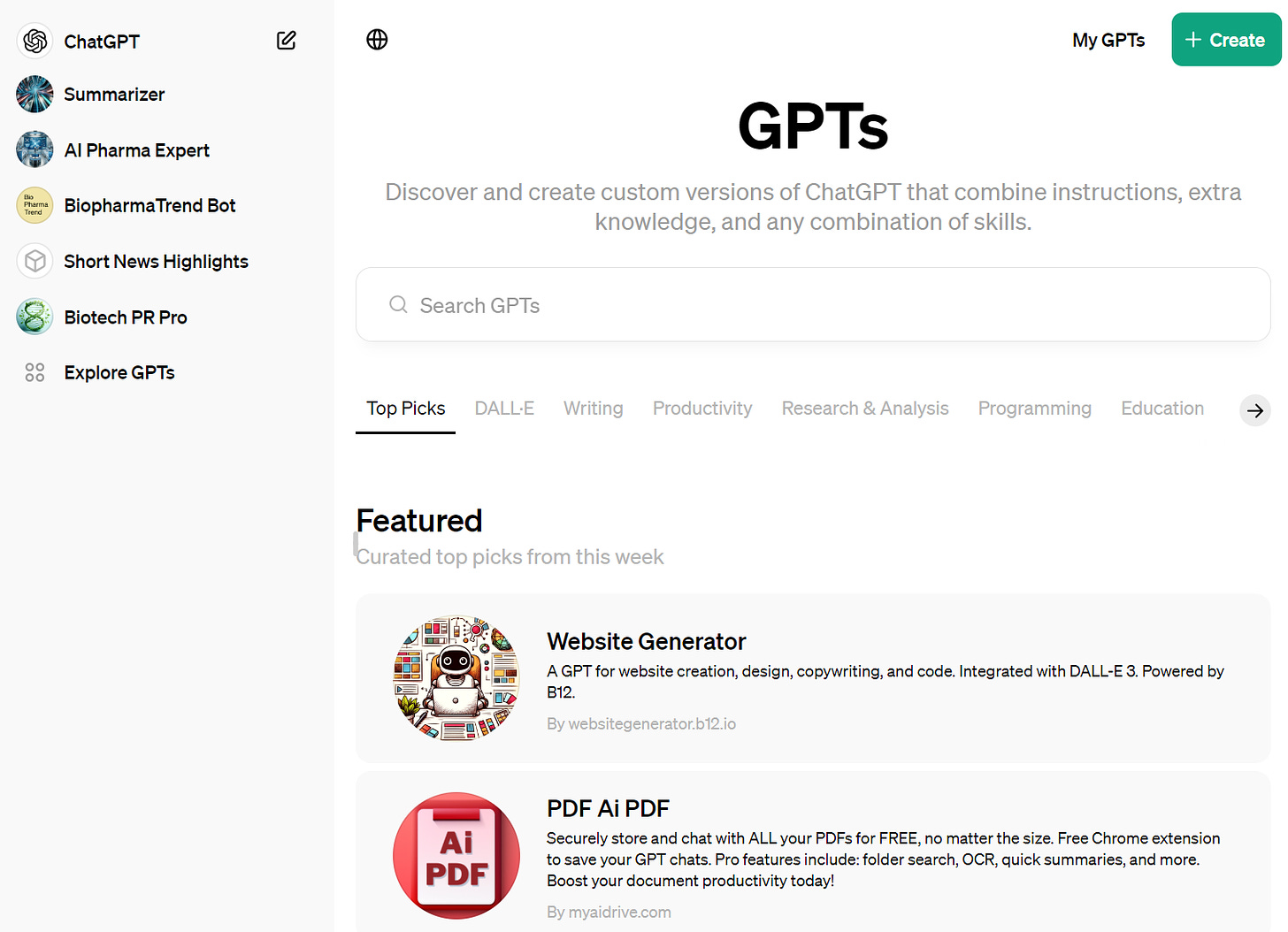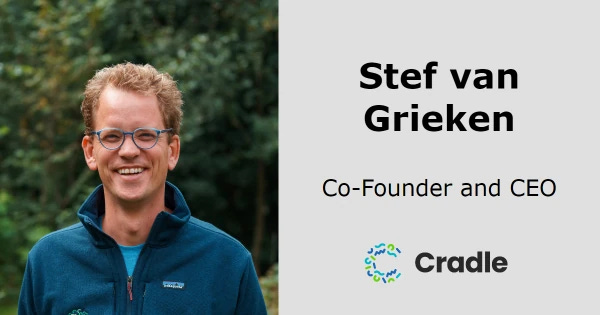How Industry Embraces Organ-on-Chips: A 2024 Status Report
ALSO: How Moderna Taps ChatGPT; Interview with Stef van Grieken, CEO of Cradle, on AI-Driven Protein Engineering; New AI in Drug Discovery Startup Launched with $1 billion
Hi! I am Andrii Buvailo, and this is my weekly newsletter, ‘Where Tech Meets Bio,’ where I talk about technologies, breakthroughs, and great companies moving the biopharma industry forward.
If you've received it, then you either subscribed or someone forwarded it to you. If the latter is the case, subscribe by pressing this button:
🚀 Now, let’s get to this week’s topics! 🚀
Moderna Enhances Partnership with OpenAI in a Bet on ChatGPT and Custom GPTs
I’m interested in OpenAI’s activity in the life sciences, because at BiopharmaTrend we use GPTs for almost a year now. And it is hard to overestimate the increase in productivity on many narrow and repetitive tasks.
OpenAI and Moderna have enhanced their collaborative efforts, introducing an advanced ChatGPT Enterprise platform to Moderna's employees.
This initiative enables the development of customized Generative Pre-trained Transformers (GPTs) tailored for distinct organizational needs. ChatGPT Enterprise allows users to build specialized GPTs by engaging in an interactive setup process that incorporates additional knowledge or specific directives into the AI model. This customization can extend to various functions, including data analysis, internet searches, and image creation.
Since initiating their partnership in early 2023, Moderna has actively integrated ChatGPT Enterprise across its teams. The initial testing phase revealed significant adoption within the company, with approximately 750 GPTs developed by Moderna's workforce within just two months. On average, each user engaged in 120 conversations weekly via the platform, and 40% of these interactions led to the creation of new GPTs tailored to specific team requirements.
With this expansion, thousands of Moderna employees will now access these AI tools, aiming to innovate and streamline processes across multiple business sectors, including legal affairs, research, manufacturing, and commercial operations. Stéphane Bancel, CEO of Moderna, expressed confidence in the transformative potential of this technology across all facets of the company's operations.
The broader availability of ChatGPT Enterprise, introduced to the public by OpenAI in November of the previous year, marks a significant milestone in customizable AI applications.
Despite the enthusiasm surrounding its application in pharmaceuticals and beyond, experts caution about the inherent limitations of ChatGPT, such as its inability to explain the origins of its predictive outcomes and its reliance on outdated data.
OpenAI acknowledges these challenges, noting that ChatGPT is not internet-connected, may deliver incorrect responses, and could generate biased or potentially harmful content.
Nevertheless, the integration of GPT technology is gaining traction across the digital health sector.
For instance, Hyro, a company specializing in GPT-enabled conversational AI for healthcare, secured $20 million in a Series B funding round last year, bringing its total capital raised to $35 million.
🚀🚀🚀
Trying to reach pharma, biotech and medtech industry executives, founders, investors, scientists and technology professionals?
What a coincidence!
This is exactly who is reading this newsletter! Reach out to learn more about sponsoring future newseltters at editor@biopharmatrend.com.
Showcase your offer to 5.6k+ industry prefessionals here on Substack or tap our 50k+ auidience on LinkedIn with 2M+ yearly impressions. We also have a range of editorial products on www.biopharmatrend.com to help you tell compelling stories about your brand.
🚀🚀🚀
Cracking the Code of Life: An Interview with Stef van Grieken, CEO of Cradle, on AI-Driven Protein Engineering
The integration of artificial intelligence (AI) in biotech is not just enhancing the efficiency of processes but is also enabling the discovery of novel biological insights that were once beyond reach. As the industry seeks to meet the increasing demand for protein-based products across various sectors, including pharmaceuticals, agriculture, and food, the role of AI becomes increasingly important.
In this context, our conversation with Stef van Grieken, Co-founder and CEO of Cradle, provides a glimpse into how cutting-edge AI technologies and strategic collaborations are accelerating the pace of innovation in protein engineering.
Stef shares the intriguing story behind Cradle's partnership with Ginkgo Bioworks, highlighting their shared vision and the synergistic combination of Cradle’s generative AI software and Ginkgo's robust experimental capabilities.
This interview delves into the growing impact of AI on biotechnological processes, the challenges currently faced by R&D teams, and how Cradle's unique approach is contributing to the protein engineering landscape.
Andrii: Stef, could you share the story behind the partnership between Cradle and Ginkgo Bioworks? What were the key factors or shared visions that led to this collaboration?
Stef: There is a significantly rising demand for more protein-based products to come to market across pharma, chemicals, food and agriculture.
Cradle was invited to be one of the founding members of the Ginkgo Technology Network to provide software that allows any R&D team to engineer better proteins using generative AI across enzymes, antibodies, cytokines, vaccines and peptides.
We are excited to work with Ginkgo, who has some of the best large-scale experimental capabilities that cover a broad range of applications. This partnership is geared towards customers who want to leverage Cradle’s generative ML for protein engineering, but who do not have the capacity to quickly validate designed proteins in a high-throughput wet lab. Taking enzyme engineering as an example, Cradle & Ginkgo can provide on-demand multi-property optimization of enzyme activity, thermal stability, pH tolerance, solvent stability, secretion, and expression in common hosts.
What we believe is unique about this partnership is that teams of scientists can now work together on optimising a protein from the comfort of their browser. With high throughput & high quality experimental data made available for further ML optimization in just 6 weeks, R&D teams can bring protein-based products to market faster without ever having to step into a lab. Both Cradle and Ginkgo have a mission to enable any team in the industry to bring bio-based products to the market in record time and we feel our capabilities are very complementary, which is why we decided to partner.
Andrii: In your view, what are the most significant impacts of integrating AI with biotechnological processes, especially in protein engineering? How does Cradle's approach differentiate from other AI applications in the field?
Stef: Developing a protein-based product is an expensive endeavour with a very high probability of your project failing. In protein engineering, we are seeing three ways in which Generative AI is making a significant impact to allow teams to have success more often with fewer experimental rounds. The first is allowing teams to find more diverse and novel sequences that would be hard to find with existing methods. We have seen with several of our customers that these models are capable of producing successful variants that are non-intuitive to trained scientists. This ultimately improves the chances of your product making it all the way to the market. The second is significantly reducing the number of experimental rounds required to get to the target product profile. Across the proteins our customers work on we are seeing 1.5x to up to 10x acceleration in multi-round optimisation across many different assays.
There are two important differences between Cradle and many other providers in the industry. First of all, we believe any team in the industry should be able to significantly speed up their discovery and development times. This is why we make our technology available as a software subscription instead of getting paid based on milestones or taking royalties. Second, we focus on hit-to-lead and lead-optimisation instead of initial discovery. This part is where most experimental cycles and money are spent to optimise proteins across many different assays. Most models out there stop delivering consistently good results as experimental rounds progress, and have a hard time suggesting highly diverse and novel sequences.
Andrii: What are some of the biggest challenges R&D teams face in protein engineering today, and how does Cradle, in collaboration with Ginkgo Bioworks, propose to address these challenges?
Stef: The collaboration with Ginkgo Bioworks is geared towards R&D teams that want to get to market faster and reduce the amount of investment required in assay development, lab infrastructure or developing in-house computational capabilities. Customers can leverage Cradle’s cutting edge generative Machine Learning to design protein libraries in a day from the comfort of their browser. At the same time, customers can request high throughput assays like activity, thermostability, pH stability, solvent stability, secretion and expression titers from the Ginkgo Foundry, with their new product “Lab data as a service”. The goal is that after only 6 weeks, scientists can be notified that high quality experimental data are ready. They can then integrate the results into Cradle’s model for further refinement. We use an easy and transparent ‘pay-per-assay’ model, where customers know what they pay with every experimental round. Teams don't need to set up assays, develop their own lab workflows and build computational tools to get their project going.
Andrii: Could you share an example or case study where Cradle's platform has significantly impacted a project or research outcome? How does this success story exemplify the potential of your technology?
Stef: A recent Cradle customer was looking to advance the biosynthesis of an active pharmaceutical ingredient by increasing the activity of a key P450 enzyme. They had reached the limits of traditional approaches, having conducted over 10 experimental rounds and tested 1200 enzyme variants. In the face of diminishing returns, they partnered with Cradle to leverage custom-trained generative Machine Learning models.
Using Cradle’s platform the Company nearly tripled activity of the target enzyme in three lab rounds, 4x faster than in previous rounds. All top 5 tested variants from these last three rounds all included novel mutations including several in non-intuitive places suggested by Cradle, as well as recombinants of previously tried mutations that drove significantly more improvement. Taken together, Cradle significantly shortened the time and cost required to reach the project objective, helping to bring novel production processes to market faster.
Andrii: With Cradle now a part of the Ginkgo Technology Network, what are your aspirations for this ecosystem? How do you see it evolving to further support innovation in biotech?
Stef: We hope that through this partnership, Cradle and Ginkgo can help R&D teams meet their experimental criteria and deliver faster progress across a wide range of sectors, from pharma to food and specialty chemicals. This collaboration unlocks on-demand experiments of high quality in only 6 weeks, where 8–12 weeks, or even longer, are typical. We believe that partnerships like this one will catalyse a reduction in the time and cost of bringing new bio-based products to market.
Andrii: What advice would you give to scientists and entrepreneurs aspiring to innovate within the biotech industry? Are there specific trends or areas of research you believe hold the most promise for the future?
Stef: I think we will see a significant reduction in the cost and time to market of bio-based products in the coming decade due to machine learning based systems. I’m not a biologist by training, so I will provide some examples of problems I think we can solve with machine learning. As with any company, it starts with solving a real problem that users have today that are in need of a solution. Here are three companies I think bright entrepreneur-scientists should be building:
Digital Animal Testing: we still use lots of animal models to test out the efficacy and safety of drugs. This is an expensive, slow, imprecise, and animal unfriendly way to test out drugs. I would love to see a company build in-silico screening methods that get close to the quality of animal models to eliminate candidates early in the pipeline.
Instruments for AI: high quality instruments are incredibly expensive. Often this is due to the high amounts of precision and sensitivity these instruments are required to have for human interpretable assays. I think machine learning based methods deal a lot better with noisy data, which may allow us to lower the cost of these instruments making them available in more places. I would love to see a company making a very noisy but high throughput mass spectrometer.
Express every protein with ease: we all too often see poor expression of proteins in different host systems especially if we transfer proteins from one species to another. I think we can learn what a well expressing protein looks like for most hosts and allow us to get to many more proteins expressing in non-native hosts with significantly higher titers
How Industry Embraces Organ-on-Chips: A 2024 Status Report
(Report written by Viraj Mehta, contributor at BiopharmaTrend.com).
Report highlights:
We are currently at an exciting juncture where several big pharmaceutical companies have started adopting such models and conducted several exploratory studies
The last 4 years have witnessed at least twofold increase in industrial validation of organ-on-chips across various fields and organ models
The majority of the studies can be broadly categorized under ADME&T (ADME & toxicity) (55.7%) followed by disease modeling on chips (30%)
The rigorous industrial testing and strong backing from regulatory agencies indicate, the next 3-5 years can be a favorable investment opportunity in such models.
Industries and CROs seeking to invest in OoC field should prioritize establishing ADME related organ-models
Investors can prioritize their investment in the OoC companies that have major focus area in ADME&T sciences




